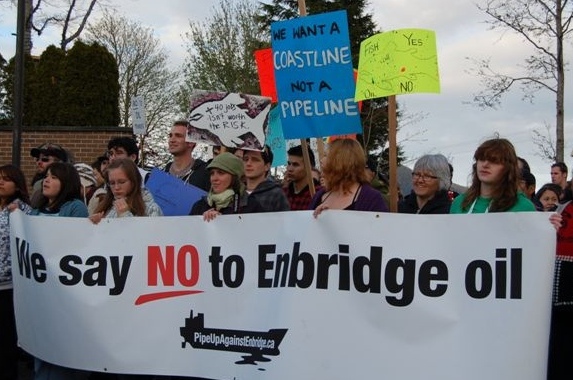With so many eyes on the proposed Northern Gateway Pipeline in northern B.C., Enbridge’s other currently proposed pipeline project — the reversal of Line 9 between Sarnia and Westover in Ontario — has been slightly in the shadows.
According to Enbridge, the existing pipeline has a capacity to pump 240,000 barrels of conventional oil per day, westbound from Montreal to Sarnia. On August 8, 2011, the company filed an application with the National Energy Board (NEB) to reverse the flow of the section between Sarnia and North Westover.
Public hearings for the project are set to start May 23 in London, Ontario, and not without controversy. With the Harper government’s ‘streamlining’ and funding slashes looming over Canada’s environmental regulatory processes, the NEB changed its mind on when the hearings would happen.
Hearing hiccups
Originally suggesting that the Hearings would be in the fall of 2012 to avoid disrupting necessary agricultural work in the spring and summer, and to accommodate the required steps for participants, the NEB announced that the hearings were now to take place from May 23-25.
Adam Scott, from intervening group Environmental Defence, believes that the sudden shortening of the timeline will prevent citizens and organizations from participating in the hearings, not to mention undercut the objectives of the environmental assessment.
“These hearings are designed to give society and citizens a chance to ask questions and have their voices heard. It takes quite a bit of time and resources for organizations and individuals to prepare for something like that and they’re basically shutting down the ability of people to participate.”
The NEB is required to provide some funding for interested groups and communities to retain expertise and further information on the project. Yet, Scott argues that NEB is missing out on important feedback by rushing to the hearings.
“These are legal proceedings, so it’s quite technical and difficult to participate already, and this just makes it that much more difficult. We’re worried that [The NEB] is not going to get as much feedback as they would have if they kept their original timeline.”
Issues with Enbridge’s proposal
Environmental Defence has also highlighted concerns that the reversal of Line 9 is actually the first step towards the Trailbreaker project, Enbridge’s 2008 proposal to reverse the flow of Line 9 Eastward from Sarnia to Montreal, effectively monopolizing tar sands oil as Ontario’s only source of crude. The full reversal would also allow tar sands bitumen access to refineries on the east coast of the US, as well as tanker exports of tar sands bitumen to US refineries near the Gulf of Mexico.
While seemingly giving away their intentions by naming the application “Line 9 Reversal Phase 1”, Enbridge maintains that Trailbreaker is not currently on the table. Scott has been pushing Enbridge to answer questions on how the economics of Phase 1 work, if not in larger context of Trailbreaker.
“They haven’t provided any information that really explains the economics of the proposal. We’re not convinced that this small piece is their ultimate intent because we feel that the project really only makes sense in the broader context of the original Trailbreaker Proposal, which would mean exporting the oil.
There are also concerns with the integrity of the nearly 40-year-old pipeline. Margaret Vance, President of the Ontario Pipeline Landowners Association, has concerns about the safety of a pipeline that has had its direction reversed once already before this proposal.
“It’s my understanding that when the flow on a pipeline is one way, patterns develop inside the pipe, when it’s reversed, of course it makes different patterns. We know that there are thinner-walled portions of Line 9 and our question is what does that do to the inside of the pipe?”
To suggest that Vance has a personal interest in the safety of the pipeline is an understatement. Her family farm has portions of three pipelines, including Line 9, running through it.
“None of us as landowners want to wake up one morning and have a field of oil, so our questions all rotate around the safety of doing this. Is this a good thing to be doing with this nearly 40-year-old pipeline?”
While safety is a significant issue, Vance says the even larger issue for landowners are plans by Enbridge and nearly every other pipeline operator in Canada to leave their pipes in ground when they’re no longer useful. For Vance, what the industry calls ‘abandonment in place’ is clearly not in the interests of landowners with pipeline easement agreements.
“[These companies] are proposing that when they’re done with the pipelines they want to give them to us, and we simply do not want them. They’ve put them there, they’ve made hundreds of billions of dollars off them, they belong to them, and when they’re junk to them, they certainly have no value to us.”
Call for Comment: Until 11:59 p.m. on April 23, the National Energy Board is open for comments on Line 9 Reversal Phase 1. You can write into the Hearings by clicking here and following the prompts.
Steve Cornwell is an MA candidate at York University. He is interested in the interactions of social movements, science and technology. Steve has worked on energy issues with Greenpeace Canada, Environmental Defense, and Safe and Green Energy PeterboroughFollow Steve Cornwell on Twitter.



